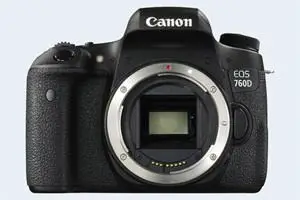Canon 760D vs Kodak AZ901
The Canon EOS 760D (called Canon T6s in some regions) and the Kodak PixPro AZ901 are two digital cameras that were officially introduced, respectively, in February 2015 and January 2016. The 760D is a DSLR, while the AZ901 is a fixed lens compact. The cameras are based on an APS-C (760D) and a 1/2.3-inch (AZ901) sensor. The Canon has a resolution of 24 megapixels, whereas the Kodak provides 20.2 MP.
Below is an overview of the main specs of the two cameras as a starting point for the comparison.

Check 760D offers at
ebay.com

Check AZ901 price at
amazon.com
Going beyond this snapshot of core features and characteristics, what are the differences between the Canon EOS 760D and the Kodak PixPro AZ901? Which one should you buy? Read on to find out how these two cameras compare with respect to their body size, their imaging sensors, their shooting features, their input-output connections, and their reception by expert reviewers.
Body comparison
The physical size and weight of the Canon 760D and the Kodak AZ901 are illustrated in the side-by-side display below. The two cameras are presented according to their relative size. Three successive views from the front, the top, and the rear are shown. All width, height and depth dimensions are rounded to the nearest millimeter.
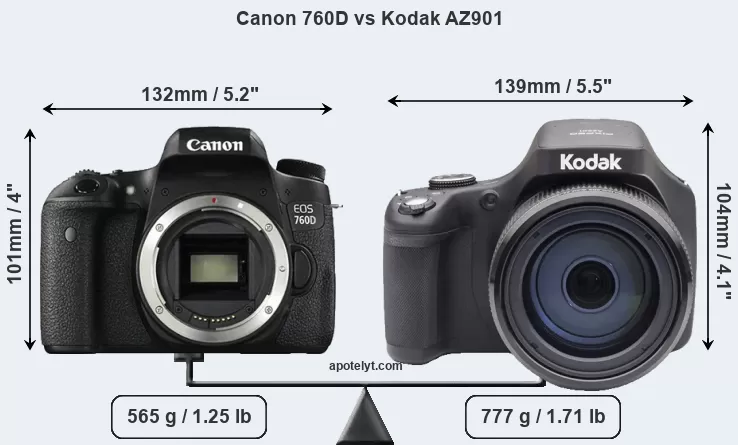
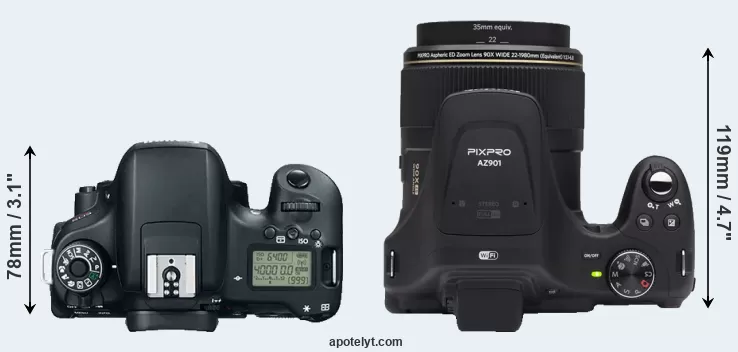
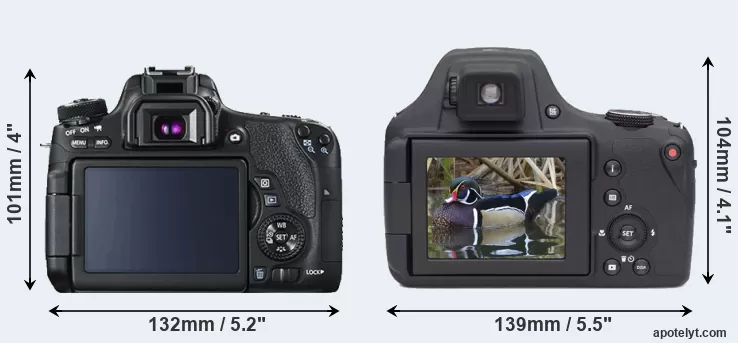
If the front view area (width x height) of the cameras is taken as an aggregate measure of their size, the Kodak AZ901 is notably larger (8 percent) than the Canon 760D. In this context, it is worth noting that neither the 760D nor the AZ901 are weather-sealed.
The above size and weight comparisons are to some extent incomplete and possibly misleading, as the AZ901 has a lens built in, whereas the 760D is an interchangeable lens camera that requires a separate lens. Attaching the latter will add extra weight and bulk to the setup. You can compare the optics available for the 760D and their specifications in the Canon EF Lens Catalog.
Concerning battery life, the 760D gets 440 shots out of its Canon LP-E17 battery, while the AZ901 can take 400 images on a single charge of its Kodak LB-070 power pack.
The following table provides a synthesis of the main physical specifications of the two cameras and other similar ones. If you would like to visualize and compare a different camera combination, you can navigate to the CAM-parator app and make your selection from a broad list of cameras there.

| Camera Model |
Camera Width |
Camera Height |
Camera Depth |
Camera Weight |
Battery Life |
Weather Sealing |
Camera Launch |
Launch Price |
Street Price |
||
|---|---|---|---|---|---|---|---|---|---|---|---|
| 1. | Canon 760D | 132 mm | 101 mm | 78 mm | 565 g | 440 | n | Feb 2015 | US$ 649 | ebay.com | |
| 2. | Kodak AZ901 | 139 mm | 104 mm | 119 mm | 777 g | 400 | n | Jan 2016 | US$ 499 | amazon.com | |
| 3. | Canon 77D | 131 mm | 100 mm | 76 mm | 540 g | 600 | n | Feb 2017 | US$ 899 | ebay.com | |
| 4. | Canon 650D | 133 mm | 100 mm | 79 mm | 575 g | 440 | n | Jun 2012 | US$ 849 | ebay.com | |
| 5. | Canon 750D | 132 mm | 101 mm | 78 mm | 555 g | 440 | n | Feb 2015 | US$ 749 | ebay.com | |
| 6. | Canon 800D | 131 mm | 100 mm | 76 mm | 532 g | 600 | n | Feb 2017 | US$ 749 | ebay.com | |
| 7. | Canon 1200D | 130 mm | 100 mm | 78 mm | 480 g | 500 | n | Feb 2014 | US$ 449 | ebay.com | |
| 8. | Canon 2000D | 129 mm | 101 mm | 78 mm | 475 g | 500 | n | Feb 2018 | US$ 449 | amazon.com | |
| 9. | Canon G1 X Mark II | 116 mm | 74 mm | 66 mm | 553 g | 240 | n | Feb 2014 | US$ 799 | ebay.com | |
| 10. | Canon G7 X | 103 mm | 60 mm | 40 mm | 304 g | 210 | n | Sep 2014 | US$ 699 | ebay.com | |
| 11. | Canon G9 X | 98 mm | 58 mm | 31 mm | 209 g | 220 | n | Oct 2015 | US$ 529 | ebay.com | |
| 12. | Canon M5 | 116 mm | 89 mm | 61 mm | 427 g | 295 | n | Sep 2016 | US$ 979 | ebay.com | |
| 13. | Leica Q Typ 116 | 130 mm | 80 mm | 93 mm | 640 g | 300 | n | Jun 2015 | US$ 4 249 | ebay.com | |
| 14. | Nikon B700 | 125 mm | 85 mm | 107 mm | 565 g | 350 | n | Feb 2016 | US$ 499 | ebay.com | |
| 15. | Nikon D5600 | 124 mm | 97 mm | 70 mm | 465 g | 970 | n | Nov 2016 | US$ 699 | ebay.com | |
| 16. | Sony HX90V | 102 mm | 58 mm | 36 mm | 245 g | 360 | n | Apr 2015 | US$ 429 | ebay.com | |
| 17. | Sony HX350 | 130 mm | 93 mm | 103 mm | 652 g | 300 | n | Dec 2016 | US$ 449 | ebay.com | |
| Note: Measurements and pricing do not include easily detachable parts, such as add-on or interchangeable lenses or optional viewfinders. | |||||||||||
Any camera decision will obviously take relative prices into account. The listed launch prices provide an indication of the market segment that the manufacturer of the cameras have been targeting. The AZ901 was launched at a lower price than the 760D, despite having a lens built in. Usually, retail prices stay at first close to the launch price, but after several months, discounts become available. Later in the product cycle and, in particular, when the replacement model is about to appear, further discounting and stock clearance sales often push the camera price considerably down.
Sensor comparison
The size of the imaging sensor is a crucial determinant of image quality. A large sensor will tend to have larger individual pixels that provide better low-light sensitivity, wider dynamic range, and richer color-depth than smaller pixel-units in a sensor of the same technological generation. Further, a large sensor camera will give the photographer additional creative options when using shallow depth-of-field to isolate a subject from its background. On the downside, larger sensors are more costly to manufacture and tend to lead to bigger and heavier cameras and lenses.
Of the two cameras under consideration, the Canon 760D features an APS-C sensor and the Kodak AZ901 a 1/2.3-inch sensor. The sensor area in the AZ901 is 92 percent smaller. As a result of these sensor size differences, the cameras have a format factor of, respectively, 1.6 and 5.6. The sensor in the 760D has a native 3:2 aspect ratio, while the one in the AZ901 offers a 4:3 aspect.
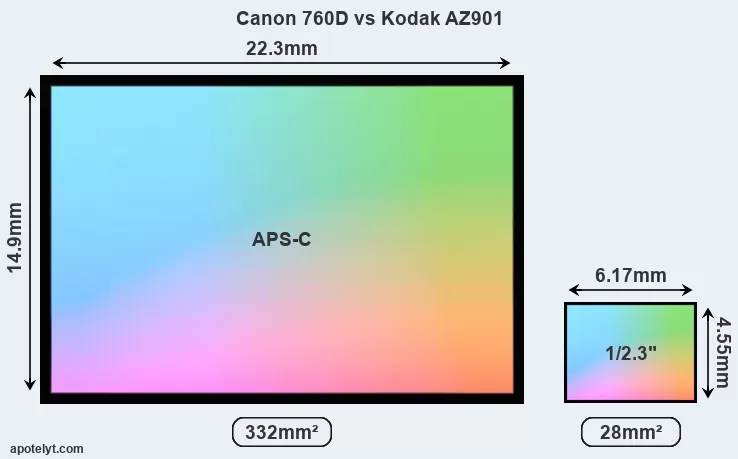
With 24MP, the 760D offers a higher resolution than the AZ901 (20.2MP), but the 760D nevertheless has larger individual pixels (pixel pitch of 3.72μm versus 1.18μm for the AZ901) due to its larger sensor. However, the AZ901 is a somewhat more recent model (by 11 months) than the 760D, and its sensor might have benefitted from technological advances during this time that enhance the light gathering capacity of its pixels.
The resolution advantage of the Canon 760D implies greater flexibility for cropping images or the possibility to print larger pictures. The maximum print size of the 760D for good quality output (200 dots per inch) amounts to 30 x 20 inches or 76.2 x 50.8 cm, for very good quality (250 dpi) 24 x 16 inches or 61 x 40.6 cm, and for excellent quality (300 dpi) 20 x 13.3 inches or 50.8 x 33.9 cm. The corresponding values for the Kodak AZ901 are 25.9 x 19.4 inches or 65.8 x 49.4 cm for good quality, 20.7 x 15.6 inches or 52.7 x 39.5 cm for very good quality, and 17.3 x 13 inches or 43.9 x 32.9 cm for excellent quality prints.
The 760D has on-sensor phase detect pixels, which results in fast and reliable autofocus acquisition even during live view operation.
The Canon EOS 760D has a native sensitivity range from ISO 100 to ISO 12800, which can be extended to ISO 100-25600. The corresponding ISO settings for the Kodak PixPro AZ901 are ISO 100 to ISO 3200 (no boost).
In terms of underlying technology, the 760D is build around a CMOS sensor, while the AZ901 uses a BSI-CMOS imager. Both cameras use a Bayer filter for capturing RGB colors on a square grid of photosensors. This arrangement is found in most digital cameras.
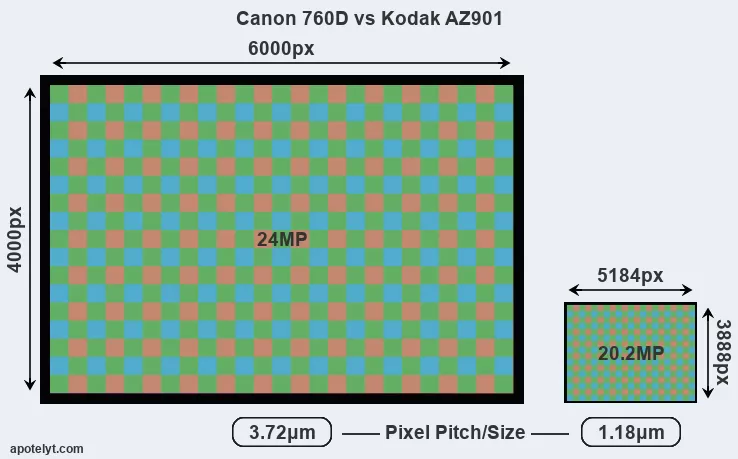
Consistent information on actual sensor performance is available from DXO Mark for many cameras. This service is based on lab testing and assigns an overall score to each camera sensor, as well as ratings for dynamic range ("DXO Landscape"), color depth ("DXO Portrait"), and low-light sensitivity ("DXO Sports"). The adjacent table reports on the physical sensor characteristics and the outcomes of the DXO sensor quality tests for a sample of comparator-cameras.

| Camera Model |
Sensor Class |
Resolution (MP) |
Horiz. Pixels |
Vert. Pixels |
Video Format |
DXO Portrait |
DXO Landscape |
DXO Sports |
DXO Overall |
||
|---|---|---|---|---|---|---|---|---|---|---|---|
| 1. | Canon 760D | APS-C | 24.0 | 6000 | 4000 | 1080/30p | 22.6 | 12.0 | 915 | 70 | |
| 2. | Kodak AZ901 | 1/2.3 | 20.2 | 5184 | 3888 | 1080/30p | 20.3 | 11.7 | 806 | 48 | |
| 3. | Canon 77D | APS-C | 24.0 | 6000 | 4000 | 1080/60p | 23.6 | 13.3 | 971 | 78 | |
| 4. | Canon 650D | APS-C | 17.9 | 5184 | 3456 | 1080/30p | 21.7 | 11.2 | 722 | 62 | |
| 5. | Canon 750D | APS-C | 24.0 | 6000 | 4000 | 1080/30p | 22.7 | 12.0 | 919 | 71 | |
| 6. | Canon 800D | APS-C | 24.0 | 6000 | 4000 | 1080/60p | 23.7 | 13.1 | 1586 | 80 | |
| 7. | Canon 1200D | APS-C | 17.9 | 5184 | 3456 | 1080/30p | 21.9 | 11.3 | 724 | 63 | |
| 8. | Canon 2000D | APS-C | 24.0 | 6000 | 4000 | 1080/30p | 22.6 | 11.9 | 1009 | 71 | |
| 9. | Canon G1 X Mark II | 1.5-inch | 13.0 | 4160 | 3120 | 1080/30p | 21.5 | 10.8 | 581 | 58 | |
| 10. | Canon G7 X | 1-inch | 20.0 | 5472 | 3648 | 1080/60p | 23.0 | 12.7 | 556 | 71 | |
| 11. | Canon G9 X | 1-inch | 20.0 | 5472 | 3648 | 1080/60p | 21.5 | 12.3 | 495 | 63 | |
| 12. | Canon M5 | APS-C | 24.0 | 6000 | 4000 | 1080/60p | 23.4 | 12.4 | 1262 | 77 | |
| 13. | Leica Q Typ 116 | Full Frame | 24.0 | 6000 | 4000 | 1080/60p | 24.3 | 12.7 | 2221 | 85 | |
| 14. | Nikon B700 | 1/2.3 | 20.2 | 5184 | 3888 | 4K/30p | 20.4 | 11.8 | 818 | 48 | |
| 15. | Nikon D5600 | APS-C | 24.0 | 6000 | 4000 | 1080/60p | 24.1 | 14.0 | 1306 | 84 | |
| 16. | Sony HX90V | 1/2.3 | 18.0 | 4896 | 3672 | 1080/60p | 20.2 | 11.6 | 738 | 47 | |
| 17. | Sony HX350 | 1/2.3 | 19.9 | 5152 | 3864 | 1080/60p | 20.5 | 11.9 | 896 | 49 | |
| Note: DXO values in italics represent estimates based on sensor size and age. | |||||||||||
Many modern cameras cannot only take still pictures, but also record videos. Both cameras under consideration are equipped with sensors that have a sufficiently high read-out speed for moving images, and both provide the same movie specifications (1080/30p).
Feature comparison
Beyond body and sensor, cameras can and do differ across a range of features. For example, the AZ901 has an electronic viewfinder (202k dots), while the 760D has an optical one. Both systems have their advantages, with the electronic viewfinder making it possible to project supplementary shooting information into the framing view, whereas the optical viewfinder offers lag-free viewing and a very clear framing image. The adjacent table lists some of the other core features of the Canon 760D and Kodak AZ901 along with similar information for a selection of comparators.

| Camera Model |
Viewfinder (Type or 000 dots) |
Control Panel (yes/no) |
LCD Specifications (inch/000 dots) |
LCD Attach- ment |
Touch Screen (yes/no) |
Max Shutter Speed * |
Max Shutter Flaps * |
Built-in Flash (yes/no) |
Built-in Image Stab |
||
|---|---|---|---|---|---|---|---|---|---|---|---|
| 1. | Canon 760D | optical | Y | 3.0 / 1040 | swivel | Y | 1/4000s | 5.0/s | Y | n | |
| 2. | Kodak AZ901 | 202 | n | 3.0 / 920 | swivel | n | 1/2000s | 5.0/s | Y | Y | |
| 3. | Canon 77D | optical | Y | 3.0 / 1040 | swivel | Y | 1/4000s | 6.0/s | Y | n | |
| 4. | Canon 650D | optical | n | 3.0 / 1040 | swivel | Y | 1/4000s | 5.0/s | Y | n | |
| 5. | Canon 750D | optical | n | 3.0 / 1040 | swivel | Y | 1/4000s | 5.0/s | Y | n | |
| 6. | Canon 800D | optical | n | 3.0 / 1040 | swivel | Y | 1/4000s | 6.0/s | Y | n | |
| 7. | Canon 1200D | optical | n | 3.0 / 460 | fixed | n | 1/4000s | 3.0/s | Y | n | |
| 8. | Canon 2000D | optical | n | 3.0 / 920 | fixed | n | 1/4000s | 3.0/s | Y | n | |
| 9. | Canon G1 X Mark II | optional | n | 3.0 / 1040 | tilting | Y | 1/4000s | 5.2/s | Y | Y | |
| 10. | Canon G7 X | none | n | 3.0 / 1040 | tilting | Y | 1/2000s | 6.5/s | Y | Y | |
| 11. | Canon G9 X | none | n | 3.0 / 1040 | fixed | Y | 1/2000s | 6.0/s | Y | Y | |
| 12. | Canon M5 | 2360 | n | 3.2 / 1620 | tilting | Y | 1/4000s | 9.0/s | Y | n | |
| 13. | Leica Q Typ 116 | 3680 | n | 3.0 / 1040 | fixed | Y | 1/2000s | 10.0/s | n | Y | |
| 14. | Nikon B700 | 921 | n | 3.0 / 921 | swivel | n | 1/4000s | 5.0/s | Y | Y | |
| 15. | Nikon D5600 | optical | n | 3.2 / 1037 | swivel | Y | 1/4000s | 5.0/s | Y | n | |
| 16. | Sony HX90V | 638 | n | 3.0 / 921 | tilting | n | 1/2000s | 10.0/s | Y | Y | |
| 17. | Sony HX350 | 202 | n | 3.0 / 922 | tilting | n | 1/4000s | 10.0/s | Y | Y | |
| Note: *) Information refers to the mechanical shutter, unless the camera only has an electronic one. | |||||||||||
One feature that is present on the 760D, but is missing on the AZ901 is a top-level LCD. While being, of course, smaller than the rear screen, the control panel conveys some of the essential shooting information and can be convenient for quick and easy settings verification.
Both cameras have an articulated rear screen that can be turned to be front-facing. This feature will be particularly appreciated by vloggers and photographers who are interested in taking selfies.Concerning the storage of imaging data, both the 760D and the AZ901 write their files to SDXC cards. The 760D supports UHS-I cards (Ultra High Speed data transfer of up to 104 MB/s), while the AZ901 cannot take advantage of Ultra High Speed SD cards.
Connectivity comparison
For some imaging applications, the extent to which a camera can communicate with its environment can be an important aspect in the camera decision process. The table below provides an overview of the connectivity of the Canon EOS 760D and Kodak PixPro AZ901 and, in particular, the interfaces the cameras (and selected comparators) provide for accessory control and data transfer.

| Camera Model |
Hotshoe Port |
Internal Mic / Speaker |
Microphone Port |
Headphone Port |
HDMI Port |
USB Port |
WiFi Support |
NFC Support |
Bluetooth Support |
||
|---|---|---|---|---|---|---|---|---|---|---|---|
| 1. | Canon 760D | Y | stereo / mono | Y | - | mini | 2.0 | Y | Y | - | |
| 2. | Kodak AZ901 | - | stereo / mono | - | - | micro | 2.0 | Y | - | - | |
| 3. | Canon 77D | Y | stereo / mono | Y | - | mini | 2.0 | Y | Y | Y | |
| 4. | Canon 650D | Y | stereo / mono | Y | - | mini | 2.0 | - | - | - | |
| 5. | Canon 750D | Y | stereo / mono | Y | - | mini | 2.0 | Y | Y | - | |
| 6. | Canon 800D | Y | stereo / mono | Y | - | mini | 2.0 | Y | Y | Y | |
| 7. | Canon 1200D | Y | mono / mono | - | - | mini | 2.0 | - | - | - | |
| 8. | Canon 2000D | Y | mono / mono | - | - | mini | 2.0 | Y | Y | - | |
| 9. | Canon G1 X Mark II | Y | stereo / mono | - | - | mini | 2.0 | Y | Y | - | |
| 10. | Canon G7 X | - | stereo / mono | - | - | micro | 2.0 | Y | Y | - | |
| 11. | Canon G9 X | - | stereo / mono | - | - | micro | 2.0 | Y | Y | - | |
| 12. | Canon M5 | Y | stereo / mono | Y | - | mini | 2.0 | Y | Y | Y | |
| 13. | Leica Q Typ 116 | Y | stereo / mono | - | - | micro | 2.0 | Y | Y | - | |
| 14. | Nikon B700 | - | stereo / mono | - | - | micro | 2.0 | Y | Y | Y | |
| 15. | Nikon D5600 | Y | stereo / mono | Y | - | mini | 2.0 | Y | Y | Y | |
| 16. | Sony HX90V | - | stereo / mono | - | - | micro | 2.0 | Y | Y | - | |
| 17. | Sony HX350 | - | stereo / mono | - | - | micro | 2.0 | - | - | - |
It is notable that the 760D has a hotshoe, while the AZ901 does not. This socket makes it possible to easily attach optional accessories, such as an external flash gun.
The AZ901 is a recent model that features in the current product line-up of Kodak. In contrast, the 760D has been discontinued (but can be found pre-owned on ebay). As a replacement in the same line of cameras, the 760D was succeeded by the Canon 77D. Further information on the features and operation of the 760D and AZ901 can be found, respectively, in the Canon 760D Manual (free pdf) or the online Kodak AZ901 Manual.
Review summary
So how do things add up? Is there a clear favorite between the Canon 760D and the Kodak AZ901? Which camera is better? The listing below highlights the relative strengths of the two models.

Arguments in favor of the Canon EOS 760D:
- More detail: Offers more megapixels (24 vs 20.2MP) with a 11% higher linear resolution.
- Better image quality: Features bigger pixels on a larger sensor for higher quality imaging.
- Richer colors: The pixel size advantage translates into images with better, more accurate colors.
- More dynamic range: Larger pixels capture a wider spectrum of light and dark details.
- Better low-light sensitivity: Larger pixels means good image quality even under poor lighting.
- Better live-view autofocus: Features on-sensor phase-detection for more confident autofocus.
- Better sound: Can connect to an external microphone for higher quality sound recording.
- Brighter framing: Features an optical viewfinder for clear, lag-free composition.
- Easier setting verification: Features an LCD display on top to control shooting parameters.
- More detailed LCD: Has a higher resolution rear screen (1040k vs 920k dots).
- Fewer buttons to press: Is equipped with a touch-sensitive rear screen to facilitate handling.
- Faster shutter: Has higher mechanical shutter speed (1/4000s vs 1/2000s) to freeze action.
- More flexible: Can take a variety of interchangeable lenses, including specialty optics.
- Better lighting: Features a hotshoe and can thus hold and trigger an external flash gun.
- Easier device pairing: Supports NFC for fast wireless image transfer over short distances.
- Faster buffer clearing: Has an SD card interface that supports the UHS-I standard.
- More heavily discounted: Has been on the market for longer (launched in February 2015).

Advantages of the Kodak PixPro AZ901:
- More framing info: Has an electronic viewfinder that displays shooting data.
- Ready to shoot: Comes with an integrated lens, while the 760D requires a separate lens.
- Sharper images: Has stabilization technology built-in to reduce the impact of hand-shake.
- More affordable: Was introduced at a lower price, despite coming with a built-in lens.
- More modern: Was introduced somewhat (11 months) more recently.
If the number of relative strengths (bullet points above) is taken as a guide, the 760D is the clear winner of the match-up (17 : 5 points). However, the relative importance of the various individual camera aspects will vary according to personal preferences and needs, so that you might like to apply corresponding weights to the particular features before making a decision on a new camera. A professional wedding photographer will view the differences between cameras in a way that diverges from the perspective of a travel photog, and a person interested in cityscapes has distinct needs from a macro shooter. Hence, the decision which camera is best and worth buying is often a very personal one.
How about other alternatives? Do the specifications of the Canon 760D and the Kodak AZ901 place the cameras among the top in their class? Find out in the latest Best DSLR Camera and Best Superzoom Camera listings whether the two cameras rank among the cream of the crop.
In any case, while the comparison of technical specifications can provide a useful overview of the capabilities of different cameras, it remains partial and cannot reveal, for example, the shooting experience and imaging performance when actually working with the 760D or the AZ901. At times, user reviews, such as those published at amazon, address these issues in a useful manner, but such feedback is on many occasions incomplete, inconsistent, and unreliable.
Expert reviews
This is why hands-on reviews by experts are important. The adjacent summary-table relays the overall verdicts of several of the most popular camera review sites (amateurphotographer [AP], cameralabs [CL], digitalcameraworld [DCW], dpreview [DPR], ephotozine [EPZ], photographyblog [PB]). As can be seen, the professional reviewers agree in many cases on the quality of different cameras, but sometimes their assessments diverge, reinforcing the earlier point that a camera decision is often a very personal choice.

| Camera Model |
AP score |
CL score |
DCW score |
DPR score |
EPZ score |
PB score |
Camera Launch |
Launch Price |
Street Price |
||
|---|---|---|---|---|---|---|---|---|---|---|---|
| 1. | Canon 760D | 5/5 | + | .. | 77/100 | 4.5/5 | 4.5/5 | Feb 2015 | US$ 649 | ebay.com | |
| 2. | Kodak AZ901 | .. | .. | .. | .. | 3.5/5 | 3/5 | Jan 2016 | US$ 499 | amazon.com | |
| 3. | Canon 77D | 4.5/5 | .. | 4/5 | 82/100 | 4.5/5 | 4/5 | Feb 2017 | US$ 899 | ebay.com | |
| 4. | Canon 650D | 4/5 | + + | .. | 77/100 | 4.5/5 | 4.5/5 | Jun 2012 | US$ 849 | ebay.com | |
| 5. | Canon 750D | 5/5 | .. | .. | 75/100 | 4.5/5 | 4.5/5 | Feb 2015 | US$ 749 | ebay.com | |
| 6. | Canon 800D | 4.5/5 | .. | 3.5/5 | 80/100 | 4.5/5 | 4/5 | Feb 2017 | US$ 749 | ebay.com | |
| 7. | Canon 1200D | 3/5 | + | .. | .. | 4/5 | 4.5/5 | Feb 2014 | US$ 449 | ebay.com | |
| 8. | Canon 2000D | 3/5 | o | 3.5/5 | .. | 3.5/5 | 3.5/5 | Feb 2018 | US$ 449 | amazon.com | |
| 9. | Canon G1 X Mark II | 3/5 | + | .. | 77/100 | 4/5 | 4.5/5 | Feb 2014 | US$ 799 | ebay.com | |
| 10. | Canon G7 X | 4/5 | + + | .. | 77/100 | 4.5/5 | 4.5/5 | Sep 2014 | US$ 699 | ebay.com | |
| 11. | Canon G9 X | 3.5/5 | + + | .. | .. | 4.5/5 | 4.5/5 | Oct 2015 | US$ 529 | ebay.com | |
| 12. | Canon M5 | 4/5 | + | 4/5 | 82/100 | 4/5 | 4/5 | Sep 2016 | US$ 979 | ebay.com | |
| 13. | Leica Q Typ 116 | 5/5 | .. | .. | 80/100 | 4.5/5 | 4.5/5 | Jun 2015 | US$ 4 249 | ebay.com | |
| 14. | Nikon B700 | .. | + | .. | .. | 4/5 | 4/5 | Feb 2016 | US$ 499 | ebay.com | |
| 15. | Nikon D5600 | 4/5 | .. | 4/5 | 79/100 | 4.5/5 | 4/5 | Nov 2016 | US$ 699 | ebay.com | |
| 16. | Sony HX90V | 4/5 | + + | .. | .. | 4/5 | 4.5/5 | Apr 2015 | US$ 429 | ebay.com | |
| 17. | Sony HX350 | .. | .. | .. | .. | .. | 4/5 | Dec 2016 | US$ 449 | ebay.com | |
| Note: (+ +) highly recommended; (+) recommended; (o) reviewed; (..) not available. | |||||||||||
The review scores listed above should be treated with care, though. The ratings are only valid when referring to cameras in the same category and of the same age. Hence, a score should always be seen in the context of the camera's market launch date and its price, and comparisons of ratings among very different cameras or across long time periods have little meaning. Also, kindly note that some of the listed sites have over time developped their review approaches and their reporting style.

Check 760D offers at
ebay.com

Check AZ901 price at
amazon.com
Other camera comparisons
Did this review help to inform your camera decision process? In case you would like to check on the differences and similarities of other camera models, just use the search menu below. Alternatively, you can follow any of the listed hyperlinks for comparisons that others found interesting.
- Canon 760D vs Fujifilm X-E1
- Canon 760D vs Leica V-LUX 5
- Canon 760D vs Nikon Z6
- Canon 760D vs Olympus PEN-F
- Canon 760D vs Panasonic S1
- Canon 760D vs Sony H200
- Canon SX420 vs Kodak AZ901
- Kodak AZ901 vs Nikon D50
- Kodak AZ901 vs Sony A1
- Kodak AZ901 vs Sony A7S III
- Kodak AZ901 vs Sony H200
- Kodak AZ901 vs Sony NEX-7
Specifications: Canon 760D vs Kodak AZ901
Below is a side-by-side comparison of the specs of the two cameras to facilitate a quick review of their differences and common features.
| Camera Model | Canon 760D | Kodak AZ901 |
|---|---|---|
| Camera Type | Digital single lens reflex | Fixed lens compact camera |
| Camera Lens | Canon EF mount lenses | 22-1980mm f/3.1-6.8 |
| Launch Date | February 2015 | January 2016 |
| Launch Price | USD 649 | USD 499 |
| Sensor Specs | Canon 760D | Kodak AZ901 |
| Sensor Technology | CMOS | BSI-CMOS |
| Sensor Format | APS-C Sensor | 1/2.3" Sensor |
| Sensor Size | 22.3 x 14.9 mm | 6.17 x 4.55 mm |
| Sensor Area | 332.27 mm2 | 28.0735 mm2 |
| Sensor Diagonal | 26.8 mm | 7.7 mm |
| Crop Factor | 1.6x | 5.6x |
| Sensor Resolution | 24 Megapixels | 20.2 Megapixels |
| Image Resolution | 6000 x 4000 pixels | 5184 x 3888 pixels |
| Pixel Pitch | 3.72 μm | 1.18 μm |
| Pixel Density | 7.22 MP/cm2 | 71.80 MP/cm2 |
| Moiré control | Anti-Alias filter | Anti-Alias filter |
| Movie Capability | 1080/30p Video | 1080/30p Video |
| ISO Setting | 100 - 12,800 ISO | 100 - 3,200 ISO |
| ISO Boost | 100 - 25,600 ISO | no Enhancement |
| DXO Sensor Quality (score) | 70 | .. |
| DXO Color Depth (bits) | 22.6 | .. |
| DXO Dynamic Range (EV) | 12.0 | .. |
| DXO Low Light (ISO) | 915 | .. |
| Screen Specs | Canon 760D | Kodak AZ901 |
| Viewfinder Type | Optical viewfinder | Electronic viewfinder |
| Viewfinder Field of View | 95% | 100% |
| Viewfinder Magnification | 0.51x | |
| Viewfinder Resolution | 202k dots | |
| Top-Level Screen | Control Panel | no Top Display |
| LCD Framing | Live View | Live View |
| Rear LCD Size | 3.0inch | 3.0inch |
| LCD Resolution | 1040k dots | 920k dots |
| LCD Attachment | Swivel screen | Swivel screen |
| Touch Input | Touchscreen | no Touchscreen |
| Shooting Specs | Canon 760D | Kodak AZ901 |
| Focus System | Phase-detect AF | Contrast-detect AF |
| Continuous Shooting | 5 shutter flaps/s | 5 shutter flaps/s |
| Fill Flash | Built-in Flash | Built-in Flash |
| Storage Medium | SDXC cards | SDXC cards |
| Single or Dual Card Slots | Single card slot | Single card slot |
| UHS card support | UHS-I | no |
| Connectivity Specs | Canon 760D | Kodak AZ901 |
| External Flash | Hotshoe | no Hotshoe |
| USB Connector | USB 2.0 | USB 2.0 |
| HDMI Port | mini HDMI | micro HDMI |
| Microphone Port | External MIC port | no MIC socket |
| Wifi Support | Wifi built-in | Wifi built-in |
| Near-Field Communication | NFC built-in | no NFC |
| Body Specs | Canon 760D | Kodak AZ901 |
| Battery Type | Canon LP-E17 | Kodak LB-070 |
| Battery Life (CIPA) | 440 shots per charge | 400 shots per charge |
| Body Dimensions |
132 x 101 x 78 mm (5.2 x 4.0 x 3.1 in) |
139 x 104 x 119 mm (5.5 x 4.1 x 4.7 in) |
| Camera Weight | 565 g (19.9 oz) | 777 g (27.4 oz) |

Check 760D offers at
ebay.com

Check AZ901 price at
amazon.com
Did you notice an error on this page? If so, please get in touch, so that we can correct the information.
